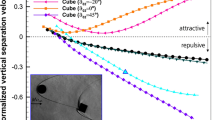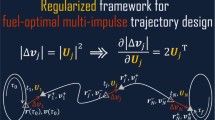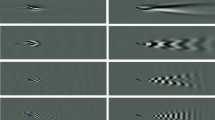Abstract
Integral transformations represent an important mathematical tool for gravitational field modelling. A basic assumption of integral transformations is the global data coverage, but availability of high-resolution and accurate gravitational data may be restricted. Therefore, we decompose the global integration into two parts: (1) the effect of the near zone calculated by the numerical integration of data within a spherical cap and (2) the effect of the far zone due to data beyond the spherical cap synthesised by harmonic expansions. Theoretical and numerical aspects of this decomposition have frequently been studied for isotropic integral transformations on the sphere, such as Hotine’s, Poisson’s, and Stokes’s integral formulas. In this article, we systematically review the mathematical theory of the far-zone effects for the spherical integral formulas, which transform the disturbing gravitational potential or its purely radial derivatives into observable quantities of the gravitational field, i.e. the disturbing gravitational potential and its radial, horizontal, or mixed derivatives of the first, second, or third order. These formulas are implemented in a MATLAB software and validated in a closed-loop simulation. Selected properties of the harmonic expansions are investigated by examining the behaviour of the truncation error coefficients. The mathematical formulations presented here are indispensable for practical solutions of direct or inverse problems in an accurate gravitational field modelling or when studying statistical properties of integral transformations.







Similar content being viewed by others
Data Availability
The global gravitational field model Tongji_GMMG2021S can be downloaded from the website of the International Center for Global Gravity Field Models. Detailed mathematical proofs of the far-zone effect formulas will be available upon request.
Code Availability
The MATLAB computer programs for the calculation of the far-zone effects will be available upon request.
References
Angermann D, Pail R, Seitz F, Hugentobler U (2022) Mission Earth. Geodynamics and Climate Change Observed Through Satellite Geodesy, Springer, Berlin, Germany. https://doi.org/10.1007/978-3-662-64106-4
Aster RC, Borchers B, Thurber CH (2013) Parameter estimation and inverse problems. Second Edition. Elsevier, Amsterdam, Netherlands. https://doi.org/10.1016/C2009-0-61134-X.
Avalos D (2009) SHGEO software package. The UNB Application to Stokes-Helmert Approach for Precise Geoid Computation. Reference Manual I. Department of Geodesy and Geomatics Engineering, University of New Brunswick, Fredericton, Canada. https://gge.ext.unb.ca/Research/GRL/GeodesyGroup/SHGeo/Manual/SHGeo_manual_I_2009.pdf
Chauvenet W (1875) A treatise on plane and spherical trigonometry, 9th edn. JB Lippincott & Co., Philadelphia, USA
Chen J, Zhang X, Chen Q, Shen Y, Nie Y (2022) Static gravity field recovery and accuracy analysis based on reprocessed GOCE Level 1b gravity gradient observations. European Geosciences Union General Assembly 2022, 23-27 May, Vienna, Austria, https://doi.org/10.5194/egusphere-egu22-6771.
Chuanding Z, Zhonglian L, Xiaoping W (1998) Truncation error formulae for the disturbing gravity vector. Journal of Geodesy 72:119–123. https://doi.org/10.1007/s001900050153
Cook AH (1950) The calculation of deflexions of the vertical from gravity anomalies. Proceedings of the Royal Society A: Mathematical, Physical and Engineering Sciences 204:374–395. https://doi.org/10.1098/rspa.1950.0182
Cook AH (1951) A note on the errors involved in the calculation of elevations of the geoid. Proceedings of the Royal Society A: Mathematical, Physical and Engineering Sciences 208:133–141. https://doi.org/10.1098/rspa.1951.0148
de Witte L (1967) Truncation errors in the Stokes and Vening Meinesz formulae for different order spherical harmonic gravity terms. Geophysical Journal International 12:449–464. https://doi.org/10.1111/j.1365-246X.1967.tb03125.x
Debnath L, Bhatta D (2015) Integral transforms and their applications, 3rd Edition. CRC Press, Taylor & Francis Group, New York, USA
Denker H, Timmen L, Voigt C, Weyers S, Peik E, Margolis HS, Delva P, Wolf P, Petit G (2018) Geodetic methods to determine the relativistic redshift at the level of \(10^{18}\) in the context of international timescales: a review and practical results. Journal of Geodesy 92:487–516. https://doi.org/10.1007/s00190-017-1075-1
EGG-C (2010) GOCE L2 product data handbook. Issue 4, Revision 3, GO-MA-HPF-GS-0110. The European GOCE Gravity Consortium EGG-C
Eshagh M (2009) On satellite gravity gradiometry. Doctoral Thesis, Royal Institute of Technology, Division of Geodesy, Stockholm, Sweden
Featherstone WE (2013) Deterministic, stochastic, hybrid and band-limited modifications of Hotine’s integral. Journal of Geodesy 87:487–500. https://doi.org/10.1007/s00190-013-0612-9
Fell PJ (1978) The influence of distant zones on Stokes’ equation considering the removal of lower-degree harmonics from \(S(\psi )\) or \(\Delta g\). Final Report, Naval Surface Weapons Center (K12), Dahlgren Laboratory, Dahlgren, VA, USA
Ganeko Y (1977a) Truncation error coefficients. Journal of the Geodetic Society of Japan 23:46-47. https://doi.org/10.11366/sokuchi1954.23.46 (in Japanese)
Ganeko Y (1977b) The errors of geoidal height computation due do the omission of detailed information of the anomaly field. Journal of the Geodetic Society of Japan 23:140–155. https://doi.org/10.11366/sokuchi1954.23.140
Hagiwara Y (1970) Truncation errors in the Stokes formula integration. Journal of the Geodetic Society of Japan 16:190-198. https://doi.org/10.11366/sokuchi1954.16.190 (in Japanese)
Hagiwara Y (1972) Truncation error formulas for the geoidal height and the deflection of the vertical. Bulletin Géodésique 106:453–466. https://doi.org/10.1007/BF02522052
Hagiwara Y (1976) A new formula for evaluating the truncation error coefficient. Bulletin Géodésique 50:131–135. https://doi.org/10.1007/BF02522312
Heiskanen WA, Moritz H (1967) Physical geodesy. Freeman and Co., San Francisco, USA
Hirt C, Rexer M (2015) Earth 2014: 1 arc-min shape, topography, bedrock and ice-sheet models - Available as gridded data and degree-10,800 spherical harmonics. International Journal of Applied Earth Observation and Geoinformation 39:103–112. https://doi.org/10.1016/j.jag.2015.03.001
Hobson EW (1965) The theory of spherical and ellipsoidal harmonics. Chelsea Publishing Company, New York, USA
Hotine M (1969) Mathematical geodesy. Environmental Science Services Administration, Monograph No. 2, US Department of Commerce, Washington DC, USA
Huang J (2002) Computational methods for the discrete downward continuation of the Earth gravity and effects of lateral topographical mass density variation on gravity and the geoid. Technical Report No. 16, Department of Geodesy and Geomatics Engineering, University of New Bruinswick, Fredericton, Canada
Jekeli C (1979) Global accuracy estimates of point and mean undulation differences obtained from gravity disturbances, gravity anomalies and potential coefficients. Report No. 288, Department of Geodetic Science and Surveying, The Ohio State University, Columbus, USA
Jekeli C (1980) Reducing the error of geoid undulation computations by modifying Stokes’ function. Report No. 301, Department of Geodetic Science, The Ohio State University, Columbus, Ohio, USA
Kellogg OD (1929) Foundations of potential theory. Verlag von Julius Springer, Berlin, Germany
Li Y (1989) Some notes on Hotine integration. Journal of Wuhan University of Surveying and Mapping 14:38-47. https://doi.org/10.13203/j.whugis1989.01.005 (in Chinese)
Martinec Z (1998) Boundary-value problems for gravimetric determination of a precise geoid. Lecture Notes in Earth Sciences, Springer, Berlin, Heidelberg, Germany. https://doi.org/10.1007/BFb0010337
Martinec Z (2003) Green’s function solution to spherical gradiometric boundary-value problems. Journal of Geodesy 77:41–49. https://doi.org/10.1007/s00190-002-0288-z
McSween HY Jr, Moersch JE, Burr DM, Dunne WM, Emery JP, Kah LC, McCanta MC (2020) Planetary geoscience. Cambridge University Press, New York, USA. https://doi.org/10.1017/9781316535769
Molodenskii MS, Eremeev VF, Yurkina MI (1962) Methods for study of the external gravitational field and figure of the Earth. The Israel Program for Scientific Translations, Department of Commerce, Washington DC, USA
Moritz H (2000) Geodetic reference system 1980. Journal of Geodesy 74:128–133. https://doi.org/10.1007/s001900050278
Neyman YM, Li J, Liu Q (1996) Modification of Stokes and Vening-Meinesz formulas for the inner zone of arbitrary shape by minimization of upper bound truncation errors. Journal of Geodesy 70:410–418. https://doi.org/10.1007/BF01090816
Novák P, Šprlák M, Tenzer R, Pitoňák M (2017) Integral formulas for transformation of potential field parameters in geosciences. Earth-Science Reviews 164:208–231. https://doi.org/10.1016/j.earscirev.2016.10.007
Paul MK (1973) A method of evaluation the truncation error coefficients for geoidal heights. Bulletin Géodésique 110:413–425. https://doi.org/10.1007/BF02521951
Paul MK (1983) Recurrence relations for the truncation error coefficients for the extended Stokes function. Bulletin Géodésique 57:152–166. https://doi.org/10.1007/BF02520922
Pavlis NK (1991) Estimation of geopotential differences over intercontinental locations using satellite and terrestrial measurements. Report No. 409, Department of Geodetic Science and Surveying, The Ohio State University, Columbus, Ohio, USA
Pishchukhina KV (1987) Methods of approximation of geoid heights and deflections of the vertical. In: Holota P (ed) Proceedings of the International Symposium Figure and Dynamics of the Earth, Moon and Planets, 15-20 September, 1986, Prague, Czechoslovakia, pp. 421–441
Rosi G, Cacciapuoti L, Sorrentino F, Menchetti M, Prevedelli M, Tino GM (2015) Measurements of the gravity-field curvature by atom interferometry. Physical Review Letters 114:013001
Rummel R (2010) GOCE: Gravitational gradiometry in a satellite. In: Freeden W, Nashed MZ, Sonar T (eds) Handbook of Geomathematics. Springer, Berlin, Heidelberg, Germany, pp. 93-103. https://doi.org/10.1007/978-3-642-01546-5_4.
Saito M (1980) Molodenskii truncation error coefficients at high degrees - stability of Hagiwara’s formula and asymptotic formula. Journal of the Geodetic Society of Japan 26:180-186. https://doi.org/10.11366/sokuchi1954.26.180 (in Japanese)
Sansò F, Sideris MG (2013) Geoid determination. Theory and methods. Springer, Berlin, Heidelberg, Germany. https://doi.org/10.1007/978-3-540-74700-0
Shepperd SW (1982) A recursive algorithm for evaluating Molodenskii-type truncation error coefficients at altitude. Bulletin Géodésique 56:95–105. https://doi.org/10.1007/BF02525595
Simmonds JG (1994) A brief on tensor analysis, Second edition. Undergraduate Texts in Mathematics, Springer-Verlag, New York, USA
Sjöberg LE (2003) A general model of modifying Stokes’ formula and its least-squares solution. Journal of Geodesy 77:459–464. https://doi.org/10.1007/s00190-003-0346-1
Sjöberg LE, Featherstone WE (2004) Two-step procedures for hybrid geoid modelling. Journal of Geodesy 78:66–75. https://doi.org/10.1007/s00190-003-0367-9
Sünkel H (1981) Feasibility studies for the prediction of the gravity disturbance vector in high altitudes. Report No. 311, Department of Geodetic Science and Surveying, The Ohio State University, Columbus, Ohio, USA
Šprlák M (2010) Generalized geoidal estimators for deterministic modifications of spherical Stokes’s function. Contributions to Geophysics and Geodesy 40:45–64. https://doi.org/10.2478/v10126-010-0003-7
Šprlák M, Hamáčková E, Novák P (2015) Alternative validation method of satellite gradiometric data by integral transform of satellite altimetry data. Journal of Geodesy 89:757–773. https://doi.org/10.1007/s00190-015-0813-5
Šprlák M, Han S-C, Featherstone W (2020) Integral inversion of GRAIL inter-satellite gravitational accelerations for regional recovery of the lunar gravitational field. Advances in Space Research 65:630–649. https://doi.org/10.1016/j.asr.2019.10.015
Šprlák M, Novák P (2014) Integral transformations of gradiometric data onto GRACE type of observable. Journal of Geodesy 88:377–390. https://doi.org/10.1007/s00190-013-0689-1
Šprlák M, Novák P (2015) Integral formulas for computing a third-order gravitational tensor from volumetric mass density, disturbing gravitational potential, gravity anomaly and gravity disturbance. Journal of Geodesy 89:141–157. https://doi.org/10.1007/s00190-014-0767-z
Šprlák M, Novák P (2016) Spherical gravitational curvature boundary-value problem. Journal of Geodesy 90:727–739. https://doi.org/10.1007/s00190-016-0905-x
Šprlák M, Sebera J, Vaľko M, Novák P (2014) Spherical integral formulas for upward/downward continuation of gravitational gradients onto gravitational gradients. Journal of Geodesy 88:179–197. https://doi.org/10.1007/s00190-013-0676-6
Tenzer R, Novák P, Prutkin I, Ellmann A, Vajda P (2009) Far-zone contributions to the gravity field quantities by means of Molodensky’s truncation coefficients. Studia Geophysica et Geodaetica 53:157–167. https://doi.org/10.1007/s11200-009-0010-1
Thalhammer M (1994) The geographical truncation error in satellite gravity gradiometer measurements. Manuscripta Geodaetica 19:45–54
Thalhammer M (1995) Regionale Gravitationsfeldbestimmung mit zukünftigen Satellitenmissionen (SST und Gradiometrie). Deutsche Geodätische Kommission, Reihe C, Nr. 437, München, Germany
Torge W, Müller J (2012) Geodesy, 4th edn. De Gruyter Inc., Berlin, Germany
Vaníček P, Featherstone W (1998) Performance of three types of Stokes’s kernel in the combined solution for the geoid. Journal of Geodesy 72:684–697. https://doi.org/10.1007/s001900050209
Wolf KI (2007) Kombination globaler Potentialmodelle mit terrestrische Schweredaten für die Berechnung der zweiten Ableitungen des Gravitationspotentials in Satelitenbahnhöhe. Deutsche Geodätische Kommission, Reihe C, Nr. 603, München, Germany
Zhou B, Luo Z, Wu Y, Cen Y (2016) Far-zone contributions of airborne gravity anomalies’ upward/downward continuation. Geodesy and Geodynamics 7:444–450. https://doi.org/10.1016/j.geog.2016.08.001
Acknowledgements
Computational resources were provided by the e-INFRA CZ project (ID:90254), supported by the Ministry of Education, Youth and Sports of the Czech Republic. The authors thank Mr. Jiří Belinger for his assistance in the numerical experiments. Thoughtful and constructive comments of two anonymous reviewers are gratefully acknowledged. Thanks are also extended to the Editor in Chief Dr. Michael J. Rycroft for handling our manuscript.
Funding
This research was supported financially by the Czech Science Foundation through the Standard Project no. 23-07031 S.
Author information
Authors and Affiliations
Contributions
MS contributed to conceptualisation, formal analysis, investigation, methodology, visualisation, writing—original draft, and writing—review and editing. MP contributed to software, validation, and visualisation.
Corresponding author
Additional information
Publisher's Note
Springer Nature remains neutral with regard to jurisdictional claims in published maps and institutional affiliations.
Supplementary Information
Below is the link to the electronic supplementary material.
Appendix A Global integral identities
Appendix A Global integral identities
Global integrals of \(T_{[k]}\) are required to get the spectral formulas for the far-zone effects in Sect. 3. These global integral identities are listed in Table 13. Equation (A3) can be found in (e.g. Heiskanen and Moritz 1967, p. 30). Hagiwara (1972) proved validity of Eqs. (A4) and (A5). Laborious mathematical derivations of Eqs. (A6) and (A7) can be found in (Thalhammer 1994, 1995; Eshagh 2009).
Equations (A8) and (A9) are, to our knowledge, original. We opt to illustrate a proof of Eq. (A8) for the interested reader. Firstly, we take the difference \(\mathcal{{D}}^{xxx} - 3 \mathcal{{D}}^{xyy}\) of the differential operators for the components of the third-order gravitational tensor in LNORF, see Eqs. (28) and (31). We set \(r = R\) \((t = 1)\) and get:
Secondly, we apply the left-hand side of the last expression to the left-hand side of the global integral identity (A3) and use the fact that \((1 - u^2)^{3/2} \frac{\partial ^3}{\partial u^3} P_{n,0}(u) = P_{n,3}(u)\). Correspondingly, the right-hand side of Eq. (A1) acts on \(T_{[k],n}\) on the right-hand side of Eq. (A3). Finally, we exploit the Legendre differential equation (e.g. Heiskanen and Moritz 1967, p. 21) to further simplify the derivatives of \(T_{[k],n}\) with respect to \(\varphi\) and \(\lambda\).
The global integral identity (A9) can be proved equivalently. In this case, however, the initial point is the difference of the differential operators \(\mathcal{{D}}^{yyy} - 3 \mathcal{{D}}^{xxy}\), see Eqs. (29) and (34).
Rights and permissions
Springer Nature or its licensor (e.g. a society or other partner) holds exclusive rights to this article under a publishing agreement with the author(s) or other rightsholder(s); author self-archiving of the accepted manuscript version of this article is solely governed by the terms of such publishing agreement and applicable law.
About this article
Cite this article
Šprlák, M., Pitoňák, M. Far-Zone Effects for Spherical Integral Transformations I: Formulas for the Radial Boundary Value Problem and its Derivatives. Surv Geophys (2024). https://doi.org/10.1007/s10712-023-09818-4
Received:
Accepted:
Published:
DOI: https://doi.org/10.1007/s10712-023-09818-4




